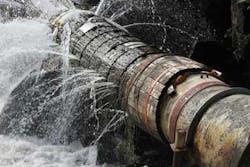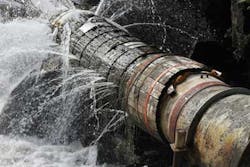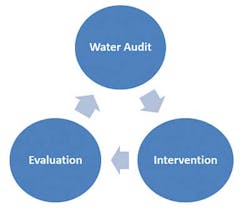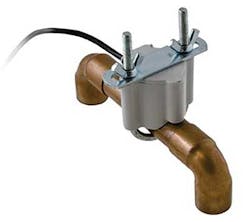Patching up the Pipes: How Smart Technologies Help Cities Prevent Leaks and Save Money
By Jesse Berst
The crisis of lost water is well quantified. The American Water Works Association indicated that the 237,600 water line breaks each year in the U.S. cost public water utilities approximately $2.8 billion annually. Further, aging, leaky pipes steal 7 billion gallons each day from our water systems, according to the American Society of Civil Engineers. And worldwide, the World Bank calculated that non-revenue water (NRW) - the industry term for the cost of water lost to leaks along with standard theft and billing errors - is approaching $14 billion.
Undeniably, these are big and bothersome numbers. Yet, while these water loss reports may dampen our spirits, there is good news: smart technologies have begun to provide a way out. They offer real solutions that are making dramatic dents in lost water and water system inefficiencies and, more importantly, ensure more sustainable water resources for our growing cities.
The concept of smart technologies encompasses the wide and evolving world of sensors, instrumentation and advanced networking that gather and present water system data, as well as the specialized data management software that analyzes it. Smart water meters, of course, have been the poster child of this development for the past decade. Accordingly, there is much discussion of smart water components that apply to water loss management.
There are two reasons one can be optimistic about the U.S. and other nations making headway on our leaky water systems. First, there are more water utilities enthusiastically wading into this world of smart leak prevention. Secondly, leak control programs have a clear payback. The ability to capture lost and unbilled water increases revenue and reduces water production costs for cities. In the fierce competition for infrastructure improvement dollars, communities are quick to push it to the top.
Before starting, it's important to recognize that smart technologies work with the standard, three-step water loss control program (see Fig. 1) that most utilities battling water loss embrace today. The steps start with a water audit to quantify and pinpoint water losses from their system. Based on the findings of an audit, the utility then implements an intervention plan and measures to reduce or eliminate water losses. Finally, they perform an evaluation using performance indicators to determine the success of their interventions.
This simple march lets utilities determine the baseline water use and loss of their systems and then prioritize and launch water efficiency projects and operational changes. The evaluation phase brings to light what worked or didn't, and they can start the process over again if greater leak prevention controls are required.
Also, the use of smart technologies to locate and repair leaky pipes is not only a factor in controlling water loss. Leak control is also impacted by managing system water pressure and the speed and quality of repairs. Here, some smart solutions around water loss control are discussed.
Smart Leak Detection Tools
To stop a water system leak, it must first be found. A variety of sensor technologies have arrived on the market to help water utilities survey their underground pipes and detect real and potential leaks. Most of these sensors locate escaping water by observing the presence of, or change to, a physical property that occurs only when a pipe or valve leaks. Sensors can employ acoustic, thermal, electromagnetic, and chemical detection techniques. Each has its own strengths and weaknesses and cost. And not all can precisely pinpoint the location or magnitude of the leak, though the smart technology is getting better all the time.
For instance, the Town of Olds in Alberta, Canada, serves as an example of how effective sensors can be. The town was in trouble because its regional supply line was nearing its maximum capacity. It faced the expensive prospect of capital infrastructure improvements to expand the supply. When a water audit using metering equipment data found that 39 percent of the water coming through its supply line couldn't be accounted for, it appeared that leak repairs might recover enough water to delay the need to increase supply. The challenge was to locate the leaks.
In 2010, the town deployed an Itron system and strategically placed acoustic sensors in service pipes that analyzed sound patterns every day, detecting new, evolving and pre-existing leaks automatically. A networked web interface interprets the data and analyzes the recordings and graphically displays all leak sensor locations using GIS and satellite mapping images, highlighting the status and location of leak occurrences. Over time, an expanding database of historical sensor information provided comprehensive condition assessment of the entire water distribution system.
In the first six months alone, 21 leaks were repaired recovering 287,691 cubic meters of water at a revenue savings of $177,336. Most leaks in the Town of Olds are service line leaks. The leak data analysis has helped the utility to target leak locations much more accurately, and non-revenue water losses have been reduced from 39 to 29 percent. The town has now integrated the proactive leak detection methodology into its daily operations.
AMI and Data Management
We've seen automated meter reading (AMR) technologies for electric, gas and water services used for some time now. These AMR-capable meters enable utility personnel to drive by or walk by a meter and, usually via a radio signal, gain data without accessing the property. The efficiencies gained here are huge and free up personnel to do system maintenance and repairs - including fixing more leaks in the system.
AMR represents the initial plunge of smart water technology. Yet the current movement to advanced metering infrastructure (AMI) with data management systems offers a more proactive way to control water loss. Unlike AMR systems, AMI enables two-way communication over a fixed network between the utility system and the metering endpoints. This robust technology typically includes data management capabilities and powerful analytics software.
The big advantage of these systems is that they not only enable utilities to efficiently read meter data but provide much greater visibility into how much water is being used, by which customers and when. With an AMI system, hourly interval reads can continuously monitor the entire water distribution network. Where AMR systems may detect leaks based on monthly or quarterly billing data discrepancies or abrupt changes in the amounts of water historically used, AMI systems see sudden increases in meter readings that may point to leakage, unauthorized use or an open valve that should be closed. It can prevent a small leak from becoming a big leak, or worse, a water main break.
Smart City Solutions
Finally, "hardware neutral" smart city solutions include the capability of processing data from leak detection devices.
In contrast to vendors that offer packages of proprietary hardware, networking and analytical software components, a few companies are rolling out system platforms with modules for water data analytics. These platforms have the ability to gather and analyze real-time data from various devices and sources. The two major companies are Microsoft with its CityNext solutions and IBM with its Smarter Cities Operations products. Such solutions are gaining traction.
For example, in Florida, the sprawling Miami-Dade County parks system suffered from an aging water infrastructure that had to be manually inspected to detect water leaks or other problems. The labor-intensive process of acquiring, integrating and analyzing historical water consumption data taxed the system's department resources. With more than $5 million in annual water and sewer costs and a consumption of more than 360 million gallons of water, the county felt it was time to get things under control. It opted to implement an IBM solution that interfaces with sensors and intelligent meters to allow county employees to remotely monitor water consumption and detect leaks via smart devices, laptops and office computers. They can often respond in near real-time to get the problem fixed.
The platform includes a web portal to easily view water consumption data to enable better monitoring and management of overall water usage and more rapidly detect leaks or potential leaks. The parks department estimates a 20-percent reduction in water use annually with a savings of some $860,000 per year.
An Easy Win
Implementing smart water leak management is not inexpensive, but the return on investment is typically apparent to the communities where utilities operate. At the Smart Cities Council, we see smart leak prevention technologies as an "easy win" for city utility managers promoting smart city initiatives.
About the Author: Jesse Berst is the Chairman of the Smart Cities Council, an industry coalition that supports cities with free smart city tools, resources and case studies.




